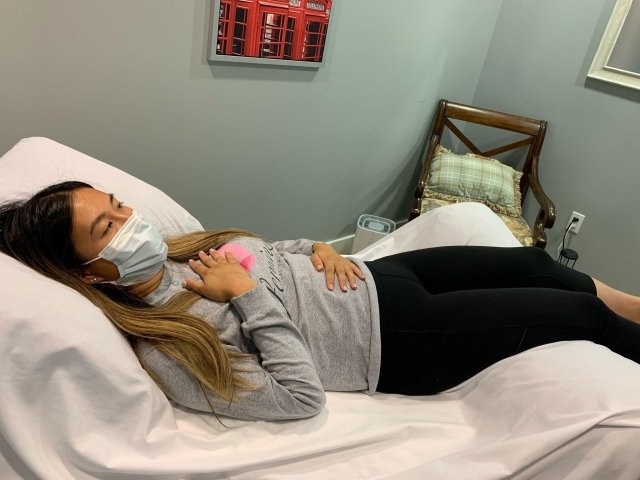
Postoperative Care for Endometriosis Laparoscopic Procedures
Recovering from an endometriosis laparoscopic procedure requires proper care for a full and timely recovery. During this time there are some important steps to follow in order for everything to go smoothly. Here is a guide that will help ensure that you return to full health as soon as possible.
The First 48 Hours After Endometriosis Laparoscopic Surgery:
- Arrange for a partner, family member, or friend to drive you home and stay with you after your procedure. General anesthesia can cause nausea and vomiting. Having a bag or bin ready for the car ride home is a good idea.
- It can also be helpful to have a small pillow or cushion to put between your abdomen and seat belt for the ride home.
- Each surgery has unique guidelines specific to your case and what was done during surgery. Follow the guidance of your surgeon and pelvic health physical therapist. As this is a general guideline It is always a good idea to speak with your health care team prior to initiating any new exercise or protocol.
- Take it easy and rest for the first 24 hours.
- Finding a position of comfort: During the initial stage of recovery it is important to find a position that is comfortable to allow your body to rest and recover.
Finding a position of comfort:
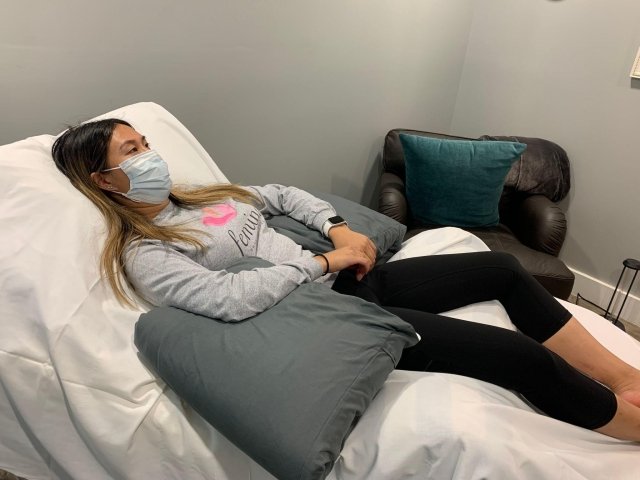
Instructions:
- Place pillows under your knees and under your shoulders and arms. Sitting slightly upright with your upper back supported on a wedge or several pillows
- This position can be helpful as it decreases any abdominal stretching.
Diaphragmatic breathing exercises:
Diaphragmatic breathing exercises: can be helpful for nervous system down training, can prevent pneumonia, improve digestion and lymphatic drainage.
Instructions:
- Lie on your back. Place a pillow under your knees.
- Place one hand over the heart and one over the belly button.
- Inhale through the nose and feel both hands rise with the in-breath. Ribs and belly are expanding, even the back of the body expands into the mat.
- Exhale gently and slowly, either through pursed lips or the nose. The air is slowly escaping as if you poked a hole in a tire with a needle and the air slowly passes out. The goal is to elongate the exhale, so that it is longer than the inhale.
- When the breath has been fully exhaled, pause for a second or two before beginning the next breath cycle again, with another inhale. After you have exhaled wait a couple of seconds until you inhale again. Continue breathing for 5-10 minutes. This exercise can be done every hour.
Don’t expect too much of yourself for the first few days. You will probably be very tired and need lots of naps. However, be sure to get up and move around as you’re able. It is important to get movement especially in your lower extremities to prevent blood clots. One exercise you can do to help with blood flow and lymphatic drainage are ankle pumps.
Ankle Pumps:
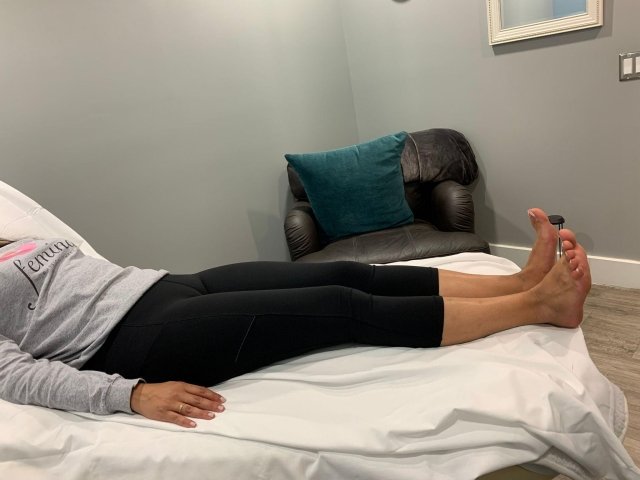
Instructions:
- Start by either lying down flat or with your back propped with pillows.
- Slowly, bring your toes up towards your nose.
- Next, point your toes down,
- Pumping up and down for 20 repetitions.
- This should be repeated 5 times per day
Calf Stretches:
Another great exercise to prevent tightness in the calves from being in bed are calf stretches.
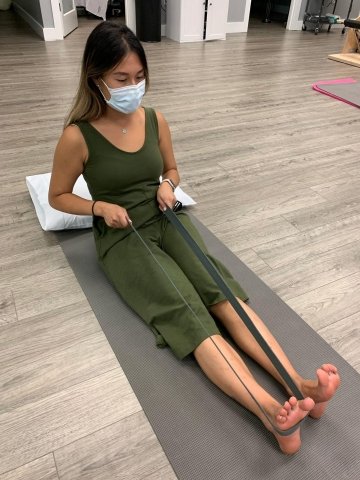
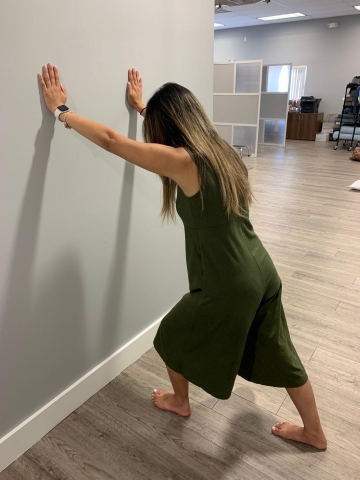
Instructions:
- This can be done either in standing or long sitting. Depending on how you are feeling, choose which position will work best for you.
- In standing:
- Place your hands on the wall and extend one leg straight backward, bending your front leg, until you feel a stretch in the calf of your back leg and hold for 30 seconds. You can also bend your back knee (while keeping your heel on the ground) to feel a stretch in a different calf muscle.
- In sitting:
- In your bed or on your couch, begin by placing a strap around the middle of your foot.
- Slowly pull your foot towards you with the strap until you feel a stretch in your calf. Hold for 30 seconds.
- With both stretches you should feel a gentle stretch in the back of the lower leg.
Post-op endometriosis laparoscopic care:
- You might be instructed not to shower or take a bath for up to 48 hours following a laparoscopy to allow the incision to heal.
- You may have some light vaginal bleeding. Wear sanitary pads if needed. Do not douche or use tampons.
- Wear loose, comfortable clothing. For a few weeks, avoid anything that puts pressure on your belly.
- Hold a pillow over your incisions when you cough or sneeze. This will support your belly and may help to decrease your pain.
After the first 48 hours:
- The most important things in the first week after endometriosis laparoscopic surgery are to keep your stools soft, drink adequate amounts of fluid (at least 64 oz. / day), and eat fiber rich foods.
- Additional stretches that are helpful for recovery at this time are modified piriformis stretches and supine butterfly stretch
Modified Figure Four Stretch:
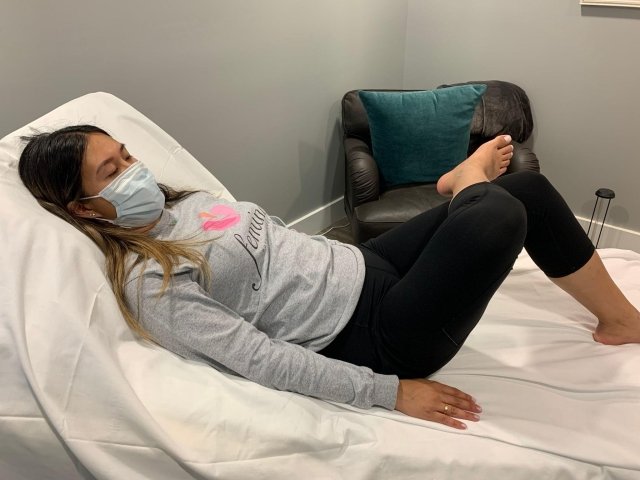
Instructions:
- Lying on your back with your knees bent and your feet flat on the ground.
- With the assistance of your arms cross lift one leg and place that ankle on your opposite knee
- Apply a gentle pressure to your bent knee with your hand. You should feel a gentle stretch in your buttocks. Hold for 30 seconds or 6 slow, deep breaths.
Supine Butterfly Stretch:
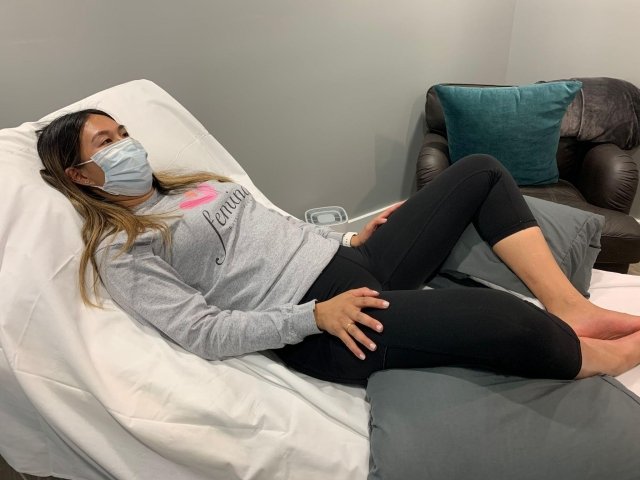
Instructions:
- Place the soles of your feet together and let your knees drop toward the floor until you feel a stretch in your inner thighs and hold for 30 seconds, or 6 slow, deep breaths.
- Make sure you do not feel pain and that it feels like a gentle stretch in your inner thighs. If you feel pain you can slide your heels away from your groin or use pillows underneath your knees.
Kegel and Transverse Abdominus Co-Contraction:
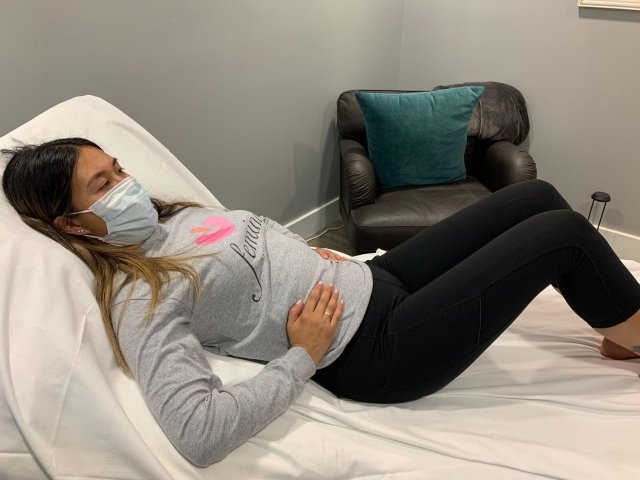
Instructions:
- While lying on your back with your legs straight or supported (pillow under your knees) start to bring your focus to your breath
- Inhale pelvic floor lengthens (use visual cues ie. sit bones spreading apart, pelvic bowl expanding)
- Exhale pelvic floor contracts (use visual cues
- It is important to reconnect to your core and progress to using this activation when getting out bed, out of a chair and bending of lifting (depending on your surgery you may be told to avoid bending or lifting for up to 8 weeks after surgery)
Post-op care from endometriosis laparoscopic procedures:
- Start taking short walks. Listen to your body, feeling for any increased pain or fatigue. If so, adjust your time so that you feel good after your walks. Start with walks in and around your house and progress to slow paced walks without inclines around your neighborhood.
- Speak to your surgeon for your specific guidelines regarding return to intercourse, tub bathing, swimming, lifting (the length of restriction will depend upon the surgery you are undergoing).
- Typically you can begin core strength training 6 weeks after the surgery but talk to your surgeon beforehand. Begin slowly under the guidance of your pelvic health therapist making sure you are engaging the muscles in the correct order and without compensations.
Some things to look out for and call your surgeon’s office if you have:
- Heavy bleeding from your vagina or incision sites
- Redness, swelling or pus at the incision sites
- An upset stomach or vomiting after the first day
- A fever higher than 101°F (taken by mouth)
- Severe pain that doesn’t get better with pain medicine
If you need additional post-surgical support after an endometriosis laparoscopic procedure, call our offices or make an appointment today.

